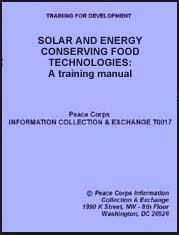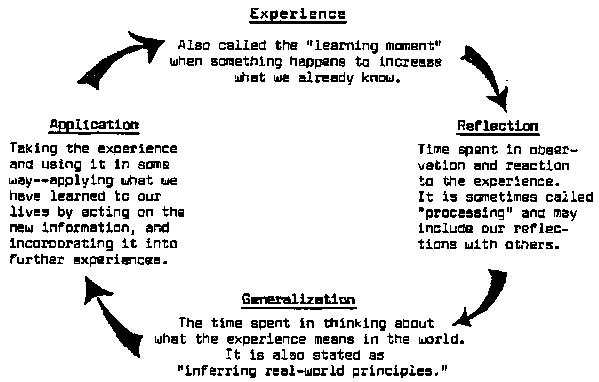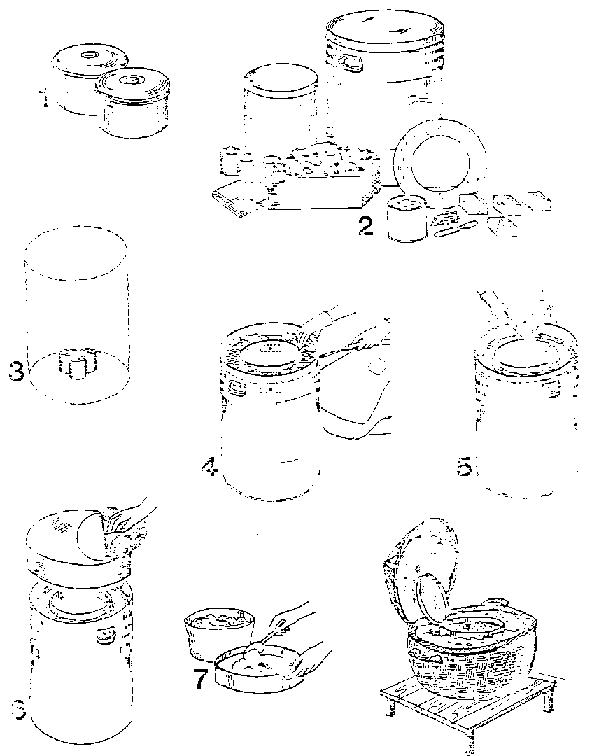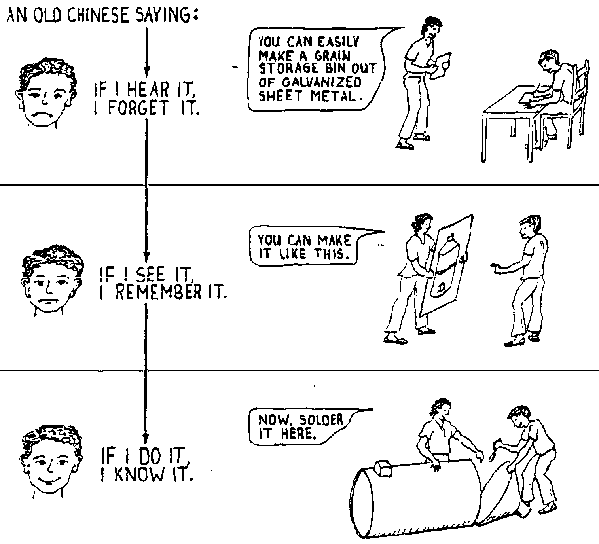
- (Peace Corps, 1984, 175 p.)
How people learn[edit | edit source]
Overview AND GOALS:
In community education, the methods used in teaching are as important as the information to be shared. The importance is underscored when there are people involved who have had little formal schooling. This session focuses on the factors that help and impede the process of "learning as discovery", as well as ideas for improving teaching and communication skills.
OBJECTIVES:
To identify situations in which learning may occur
To examine obstacles to learning, and devise ways to overcome them
To identify effective teaching methods and techniques, and to gain practice in using them
RESOURCES:
Helping Health Workers Learn, Chapters 1, 5-7 and 11-19.
Perspectives on Non-Formal Adult Learning, (Photo Parade), op. 85-88.
Bridging the Gap
Improved Food Storage and Training Manual, Session 8.
HANDOUTS:
Photo Parade Observation Form Handout 12A
"The Experiential Learning Model" Handout 12B
MATERIALS:
Pens or pencils for each participant
Newsprint and markers, or chalkboard and chalk
PREPARATION:
Locate 5 or 6 photographs illustrating learning and teaching situations, find examples of: directive teaching, two-way learning, authoritarian teaching, classroom and informal situations. Refer to Helping Health Workers Learn and materials from World Neighbors for some examples. Use local textbooks and other information sources within the country for other examples. Make enough sets of photographs for use during the session.
Ask for volunteers to prepare two role-play situations with the theme of effective and ineffective ways of teaching. (Refer to Helping Health Workers Learn, Chapter 1, pp. 17-23)
PROCEDURES AND ACTIVITIES:
- (10 minutes) Introduction and Warm-up Activity
Draw nine cats on a chalkboard or sheet of newsprint:
Ask everyone to try to figure cut a way to connect all the dots with four straight lines joined together, without lifting the pencil from the paper. Give a clue: To solve the puzzle, people must go beyond the limits they have set for themselves.
TRAINER'S NOTES
It is possible that no one will come up with the answer. Should that occur, help the participants by giving more clues. Encourage people to help one another, since one of the purposes of the exercise is to start thinking about - and practicing effective learning methods. Perhaps someone in the group will devise a different solution, but this is one way of doing it:
- (20 minutes) Photo Parade
Have the participants form groups of 5 or 6. Distribute to each group copies of Handout 12A and identical photographs showing learners and teachers in different roles and in a variety of situations. Each person should look at one photo at a time and fill in the appropriate space on the Photo Parade Observation Form. After each photo is studied it should be passed on, so that everyone has a chance to study each photo. When the full parade of photos has passed, the participants should discuss and compare their responses to each photo.
TRAINER'S NOTE
Some or all of this activity may be done in the large group, depending on time considerations, and the size and dynamics of the group.
- (20 minutes) Discussion
Some questions to include are: In the photos,
- Which situations seemed most comfortable for learning?
- What obstacles to learning were apparent in the photos?
- In what kinds of situations do you learn best?
- What are some things you've learned outside the formal school system?
- How influential is a teacher in either helping you learn or keeping you from learning?
- (10 minutes) Experiential Learning
Distribute and discuss the experiential learning model (Handout 12B), and ask for anecdotes that in some way relate to the learning loop. Encourage questions and comments regarding the way that people learn.
- (20 minutes) Effective and Ineffective Teaching
Have a group of volunteers present two role-play situations to illustrate ways of teaching the same material using effective and ineffective methods.
TRAINER'S NOTE
The role-plays may focus on teaching some aspect of solar food dryer theory or construction. If time permits, you may wish to ask the entire group to participate in the activity. It is useful to have the specific role play situation written on a slip of paper for each group. For example: Show a group of community members how to build a tray for a dryer. In the first roleplay, show an ineffective way of teaching; in the second, a more appropriate approach.
After the role-plays, discuss:
- the methods and ideas that helped learning occur
- the obstacles to learning in each situation
- (10 minutes) Ideas for Learning
Introduce the idea of "brainstorming" as an effective way to gather a lot of ideas in a short period of time. Remind people that the technique involves listing as many ideas as possible, without judging whether they should or should not appear on the list.
Ask for suggestions about ideas, methods, tools and techniques that can help people learn in a community setting. Keep a list on newsprint or chalkboard.
The list should include: stories, posters, displays, slides or films, bulletin boards, role-plays, puppet shows, field trips, "hands an" practice, drama and village theater.
- (15 minutes) Summary
Guide a discussion based on the following questions:
- What are some potential problems in sharing information at the community level?
- How can community members be involved in their own education?
- What are some ways to break down barriers to learning?
- What kinds of learning are traditional in your community?
- What kinds of learning situations seem to work well in your community?
- Which of the ideas listed may be appropriate for use in your community?
Point out that people will have the opportunity during the course to practice and develop teaching tools and methods that will be useful in community work.
PHOTO OBSERVATION FORM
|
Photo: |
1 |
2 |
3 |
4 |
5 |
- WHO IS THE EXPERT IN THIS PHOTO?
a. the one who seems to be a community worker or teacher
b. participant
c. both
d. can't tell
- WHAT ROLES ARE THE PARTICIPANTS PLAYING?
a. active
b. passive
c. can't tell
- HOW MANY OF THE PARTICIPANTS SEEM INTERESTED?
a. few
b. many
c. all
- HOW WOULD YOU CLASSIFY THE COMMUNICATION THAT IS TAKING PLACE IN THE PHOTO?
a. from community worker/teacher to learners
b. from learners to health worker
c. mutual
- HOW WOULD YOU DESCRIBE THE HUMAN RELATIONS HERE?
a. authoritarian or dependent
b. mutual respect
c. can't tell
- IS THE "TEACHER' S" ROLE IN THIS TYPE OF LEARNING SITUATION EASY OR HARD?
a. easy
b. hard
- DO YOU THINK THE APPROACH SHOWN HERE IS APPROPRIATE TO VILLAGERS?
a. in most situations
b. in some situations
c. never
THE EXPERIENTIAL LEARNING MODEL hen we learn something - a task, a skill, knowledge of some sort, or even how to avoid something, like a hot stove - we go through stages of absorbing the new information, and finally using it in a way that has meaning to us. The learning loop, as it is called, may be visualised like this:
Experience
An illustration: A child approaches a hot stove and tentatively puts a hand out to feel what is there. As his hand touches hot metal, he withdraws it and cries out in pain. He thinks, on some level, "stoves are hot, they burn and cause pain." Next time (or however many times it takes to make the connection), he is cautious about touching stoves and may not even want to go near one, hot or cold, for a long time. First, there was the experience of burning and pain; then, of reflecting and sharing feelings (calling out to mother); then of generalizing stoves are hot, and applying that knowledge to the next experience. It may be that the child will find out that all stoves are, in fact, not hot, and that he will have to be cautious only when he knows (through observation, experience, and second-hand information) that the stove is lit.
Experience becomes a art of learned knowledge and goes on to provide information for new experiences.
Experience
We all learn best when we take an active part in finding out things that are new to us!
- A class in which we take part in discussions is more interesting than a class in which we just listen to a lecture.
- A class in which we can see for ourselves what things look like and how they work, is more interesting than a class in which we only talk about things.
- A class in which we not only talk and see, but actually do and make and discover things for ourselves, is exciting! When we learn by finding things out for ourselves, by building on experience we already have, we do not forget. What we learn through active discovery becomes a part of us.
Experience
From Helping Health Workers Learn



